
Walter Whitman Jr. was an American poet, essayist, and journalist. He is considered one of the most influential poets in American history. Whitman incorporated both transcendentalism and realism in his writings and is often called the father of free verse. His work was controversial in his time, particularly his 1855 poetry collection Leaves of Grass, which was described by some as obscene for its overt sensuality.

Dupont Circle is a historic roundabout park and neighborhood of Washington, D.C., located in Northwest D.C. The Dupont Circle neighborhood is bounded approximately by 16th Street NW to the east, 22nd Street NW to the west, M Street NW to the south, and Florida Avenue NW to the north. Much of the neighborhood is listed on the National Register of Historic Places. However, the local government Advisory Neighborhood Commission and the Dupont Circle Historic District have slightly different boundaries.

Dupont Circle station is an underground rapid transit station on the Red Line of the Washington Metro in Washington, D.C. Located below the traffic circle, it is one of the busiest stations in the Metro system, with an average of 16,948 entries each weekday. The station parallels Connecticut Avenue NW between the southern edge of the circle to the south and Q Street NW to the north.

Mount Pleasant is a neighborhood in the northwestern quadrant of Washington, D.C. It is bounded by Rock Creek Park to the north and west; Harvard Street NW to the south; and 16th Street NW to the east. It is north of Adams Morgan and west of Columbia Heights. It is home to about 10,000 people.

Logan Circle is a historic roundabout park and neighborhood of Washington, D.C., located in Northwest D.C. The majority of Logan Circle is primarily residential, except for the highly-commercialized 14th Street corridor that passes through the western part of the neighborhood. In the 21st century, Logan Circle has been the focus of urban redevelopment and become one of Washington's most expensive neighborhoods. Today, Logan Circle is also one of D.C.'s most prominent gay neighborhoods.

Shepherd Park is a neighborhood in the northwest quadrant of Washington, D.C. In the years following World War II, restrictive covenants which had prevented Jews and African Americans from purchasing homes in the neighborhood were no longer enforced, and the neighborhood became largely Jewish and African American. Over the past 40 years, the Jewish population of the neighborhood has declined but the neighborhood has continued to support a thriving upper and middle class African American community. The Shepherd Park Citizens Association and Neighbors Inc. led efforts to stem white flight from the neighborhood in the 1960s and 1970s, and it has remained a continuously integrated neighborhood, with very active and inclusive civic groups.

Forest Hills is a residential neighborhood in the northwest quadrant of Washington, D.C., United States, bounded by Connecticut Avenue NW to the west, Rock Creek Park to the east, Chevy Chase to the north, and Tilden Street NW to the south. The neighborhood is frequently referred to as Van Ness, both because of its proximity to the University of the District of Columbia (UDC)'s Van Ness campus, and because it is served by the Van Ness–UDC station on the Washington Metro's Red Line.
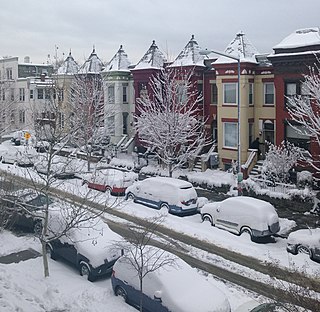
Bloomingdale is a neighborhood in the Northwest quadrant of Washington, D.C., less than two miles (3 km) north of the United States Capitol building. It is a primarily residential neighborhood, with a small commercial center near the intersection of Rhode Island Avenue and First Street NW featuring bars, restaurants, and food markets.

Florida Avenue is a major street in Washington, D.C. It was originally named Boundary Street, because it formed the northern boundary of the Federal City under the 1791 L'Enfant Plan. With the growth of the city beyond its original borders, Boundary Street was renamed Florida Avenue in 1890.

Lincoln Park is the largest urban park located in the Capitol Hill neighborhood of Washington, D.C. It was known historically as Lincoln Square. From 1862 to 1865, it was the site of the largest hospital in Washington, DC: Lincoln Hospital.

Cadman Plaza is a park located on the border of the Brooklyn Heights and Downtown Brooklyn neighborhoods in Brooklyn, New York City. Named for Reverend Doctor Samuel Parkes Cadman (1864–1936), a renowned minister in the Brooklyn Congregational Church, it is built on land reclaimed by condemnation in 1935 and was named as a park in 1939. The park borders Cadman Plaza West and Cadman Plaza East and the west and east sides of the plaza, respectively.
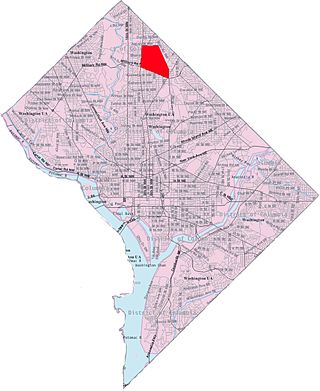
Manor Park is a neighborhood in Ward 4 of northwest Washington, D.C.

North Cleveland Park is a neighborhood in the Northwest quadrant of Washington, D.C.

Downtown is the central business district of Washington, D.C., located in Northwest D.C. It is the fourth largest central business district in the United States. The "Traditional Downtown" has been defined as an area roughly between Union Station in the east and 16th Street NW in the west, and between the National Mall on the south and Massachusetts Avenue on the north, including Penn Quarter. However, nowadays, Downtown D.C. usually refers to a larger area, as the DC Office of Planning states:
…most residents, workers, and visitors think of Downtown in a broader sense — including areas as far north as Dupont Circle, as far west as Foggy Bottom, and as far east as Capitol Hill. Only about half of the central city workforce is located within the city’s traditional Downtown.

Brightwood Park is a small neighborhood in Northwest Washington, D.C. in the United States. The neighborhood is bounded by Georgia Avenue NW to the west, Missouri Avenue NW to the northeast and Kennedy Street NW to the south. More recently, areas that are technically part of the northern extremity of the Petworth neighborhood have been increasingly referred to as Brightwood Park. Often these informal boundaries extend south to Emerson Street NW, and east to New Hampshire Avenue NW. Another definition places Hamilton Street NW as Brightwood Park's southern boundary. Yet another definition places Brightwood Park's southern boundary as Ingraham Street NW. The most expansive definition state Brightwood Park's borders as Missouri Avenue to the north, North Capitol Street on the east, Emerson Street to the south and Georgia Avenue on the west. It is located in Ward 4.
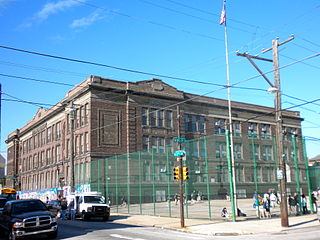
Whitman is a neighborhood in the South Philadelphia section of Philadelphia, Pennsylvania, United States. It is bounded on the west by Sixth Street, on the east by Front Street, on the south by Bigler Street, and on the north by Snyder Avenue. The name "Whitman" was adopted when the nearby Walt Whitman Bridge was being constructed in the 1950s. In 2015, Whitman and nearby South Philadelphia neighborhoods were named by Philadelphia Magazine as one of the safest and most family-friendly neighborhoods in Philadelphia.
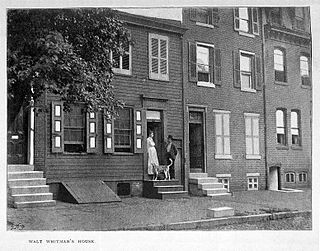
The Walt Whitman House is a historic building in Camden, New Jersey, United States, which was the last residence of American poet Walt Whitman, in his declining years before his death. It is located at 330 Dr. Martin Luther King Jr. Boulevard, known as Mickle St. during Whitman's time there.
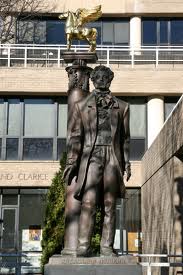
Alexander Pushkin is a bronze statue by Alexander Bourganov. It is located at the corner of 22nd Street and H Street, N.W. Washington, D.C., on the campus of George Washington University. It was erected as part of a cultural exchange between the cities of Moscow and Washington; in 2009, a statue of the American poet Walt Whitman was erected in Moscow. Pushkin's statue is said to be the first monument commemorating a Russian literary figure in the United States.

Pillar of Fire is an illuminated glass sculpture in Washington, D.C. honoring Whitman-Walker Health and the healthcare workers who assisted people living with HIV/AIDS during the height of the AIDS epidemic. Designed by artist William Cochran, the sculpture is composed of 370 layers of float glass that changes colors throughout the day. It was installed in 2013 in front of the old Whitman-Walker Clinic site at 14th and S Streets NW. The design was inspired by the ancient tale of a pillar of fire that led Israelites in their crossing of the Red Sea and through the desert after they fled Egypt.

Walt Whitman Park is a park in the Downtown Brooklyn section of Brooklyn, New York City, commemorating Walt Whitman. It is adjacent to Cadman Plaza East to the west and Adams Street to the east.




















